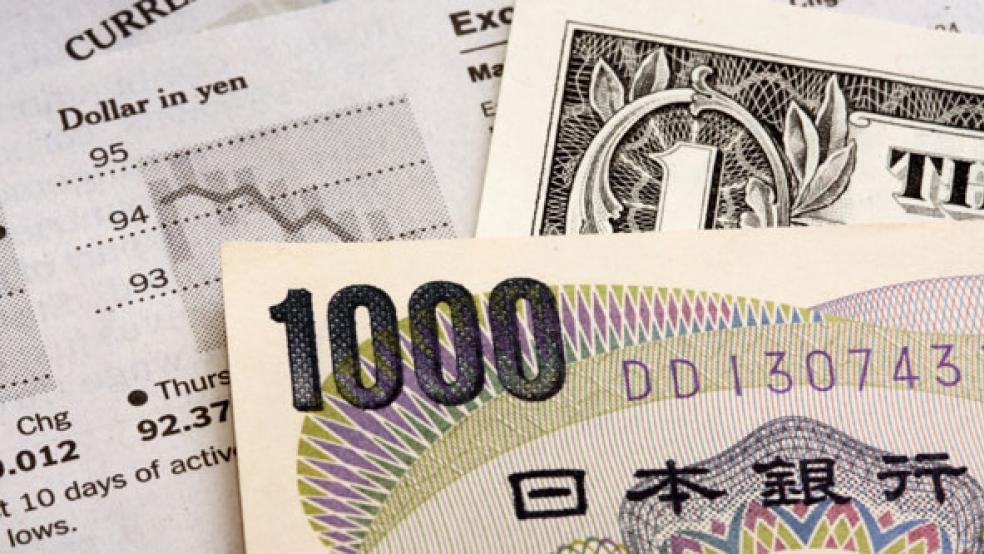Mayday! The dollar is under attack. Last week’s big news was that the dollar had dropped to a post-war low against the yen. Imagine: the dollar traded lower against the yen, at Y75.31, than it has at any time in more than six decades. Lower than during the 1980s, when it looked like Japan was about to acquire the entire United States, or at least Hawaii.
This is alarming to Japanese authorities, who on Monday announced efforts to ratchet down the exchange rate. Their buying program is reportedly huge – involving purchases of up to five trillion yen, which would be an all-time record. Japan’s leaders are anxious about the impact the ever-strengthening currency will have on its economy, and especially on its all-important exports sector.
Shouldn’t our leaders be a tad anxious too? The dollar’s slump versus the yen is a marker, one of many now, of how investors perceive U.S. prospects. Japan, with a public debt to GDP ratio of 230 percent, is second highest in the world, behind Zimbabwe. Moreover, the country has been stuck in economic limbo for years. This is not a comparison we should welcome.
Investors appear capable of focusing on only one thing at a time; currently, all eyes are on the turmoil in the Eurozone. Because of fiscal issues in that arena, the dollar has maintained its value against the euro, trading higher and lower over the past five years depending on financial trends, but within a range of $1.59 (at the height of the financial crisis in 2008) and a low of $1.20 struck in 2010. It is currently valued at $1.37. However, holding up versus the euro is like being the skinniest hog – it doesn’t say much.
has taken over the past
decade may boost our
ability to export goods
but it will ultimately crank
up price increases here.
The dollar has tumbled not only compared to the yen – it has also been demolished relative to the Swiss franc. In late 2000, the franc was worth $0.55; as of August, it had soared to $1.30. Thanks to aggressive interventions by Swiss authorities, it is currently selling at $1.12. Don’t forget the Canadian dollar – that was worth $0.62 in early 2002, and is now trading near parity. Or gold -- that ultimate measuring stick, which in dollar terms has more than tripled in the past five years.
The hit that our currency has taken over the past decade may boost our ability to export goods but it will ultimately crank up price increases here and eventually lift interest rates as well. It is not a healthy signpost.
This prospect has been derided by those on the left who consistently agitate for increased government spending and dismiss concerns about our ever-increasing debt burden. They have been able to point to strong and persistent demand for U.S. government debt and low interest rates (and inflation) to justify their insouciance. Nervous investors worldwide have plowed into U.S. Treasuries, as they always have in times of turmoil, keeping prices high and yields low. Of course, low rates are also nurtured by meager economic growth at home and by the quantitative easing measures undertaken so expansively by the Federal Reserve. We even sustained a credit downgrade – the first ever- with but a hiccup in our interest rates. This will not persist.
Critics of efforts to rein in U.S. deficits have pointed to slowing growth in the U.K. as indicative of the risks run by overly aggressive austerity programs. The conservative Cameron government in the UK was elected on a platform to turnaround the sinking financial outlook for the country, and they have embraced a host of efforts to cut spending. Cuts which, arguably, have trimmed growth.
However, as Prime Minister Cameron wrote in an op-ed this week in the Financial Times, the U.K. went into the financial crisis with the “biggest structural deficit in the G7 and came out of it with a deficit forecast to be the biggest in the G20.” As he points out, because his government has tackled the bloated spending bequeathed by his predecessors, interest rates being paid by the U.K. today are half what is now demanded for Italian or Spanish borrowings. He also boasts that Standard & Poor’s recently reaffirmed the U.K.’s triple-A credit rating. He can be excused for noting that this was the same agency that took away that seal of ultimate approval from the U.S.
President Obama and his colleagues in Congress argue that spending should be cut in the out years but that in the meantime we need to prop up growth through ever-rising deficits. The risk is that there will be another bump in the road, another financial crisis – perhaps brought on by the very real prospect that the EU simply cannot manage their spreading debt woes – and that our government will have no fuel left in the tank. Ironically, another grave risk is that the EU sorts out its issues, presenting global capital with an alternative safe haven. Either way, at some point there will be a price to pay for our rising debts and inability to rein in our health and retirement programs.
Naturally, this puts great pressure on the work of the Congressional deficit committee. Failure could mean that in a few years it will be the U.S. begging the Chinese for help. Then we will be forced to make sacrifices that are today unthinkable. This could happen; the yen tells us so.




